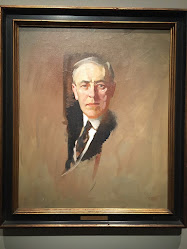The fourth edition of the Twitter Presidents series introduces a new, consequential era in American history. The politicians who ascended to the highest office at the end of the Gilded Age and in the first half of the twentieth century were influential trailblazers as well as unavailing placeholders. America's economy gradually strengthened following the Civil War and was steamrolling at the same time when the government attempted to engage in imperialism. The United States experimented its military strength against a crippling European power in the 1898 Spanish-American War; as a result, Uncle Sam acquired a small overseas empire (which included Cuba, Philippines, Guam, Puerto Rico, and the Sandwich Islands). In spring 1917, America entered the Great War in Europe, flexing its muscles and cementing its global position as a defender of liberty and the authoritative policeman of the world. At the start of the 1920s, America experienced a growth in culture and fine arts - theaters, radio, moving pictures, and dance halls shaped vibrant communities. Since the 'Roaring Twenties' saw a rise of consumerism, overproduction and credit debt soared to unbelievable heights, terminating in the Stock Market Crash of 1929 and the Great Depression (our darkest days). At the start of the 1940s, America was a different place than it was at the conclusion of the Gilded Age, built on prosperity and greediness. Presidential portraits are located in the National Portrait Gallery in D.C., photographs from author's collections.
William McKinley– 25th man to hold the office & last president to have served in the Civil War. In office, McKinley raised protective tariffs to promote domestic industry, kept the nation on a gold standard & won the Spanish-American War (1898). Yet, he was killed in 1901. (December 15, 2018)
 |
| W. McKinley, 1897-1901 |
Theodore Roosevelt– a young gun who was thrust into political office following the assassination of W. McKinley. A driving force in the Progressive Era, Roosevelt championed domestic policies for the common man, regulated food & drug principles, and created the national parks. (December 15, 2018)
 |
| T. Roosevelt, 1901-1909 |
William H. Taft– America’s biggest pres. Roosevelt’s secretary of war & handpicked successor, Taft swayed away from conservative progressive policies his predecessor had put forth & reached beyond party lines. He also focused on East Asian affairs. Later he was SC chief justice. (December 16, 2018)
 |
| W. Taft, 1909-1913 |
Woodrow Wilson– the ‘professor’ president. A PhD in poli science, president of Princeton Uni, and gov. of New Jersey, Wilson brought a different approach to D.C. He enforced economic regulations, gave women the vote, and won WWI. However, his League of Nations vote failed. (December 16, 2018)
 |
| W. Wilson, 1913-1921 |
Warren G. Harding– the Republican lone horse who stole the show in 1920. A former senator, Harding ascended to the highest office during a time when peace was wanted and money was spent. Harding executed a plan to limit naval programs worldwide, however scandals clouded his tenure. (December 17, 2018)
 |
| W. Harding, 1921-1923 |
Calvin Coolidge- an intelligent, quiet man. Coolidge, the former governor of Massachusetts, was sworn in by his father, a justice of peace, upon the sudden death of W. Harding. He championed small government, progressive conservative policies & restored public confidence in D.C. (December 17, 2018)
 |
| C. Coolidge, 1923-1929 |
Herbert Hoover- an engineer who exceeded expectations in his role as secretary of commerce in the 1920s, however, failed as president. Hoover’s usual energetic self was destroyed within the first year in office w/ the 1929 Wall Street Crash. He tried to lift the economy–no luck. (December 18, 2018)
 |
| H. Hoover, 1929-1933 |


No comments:
Post a Comment